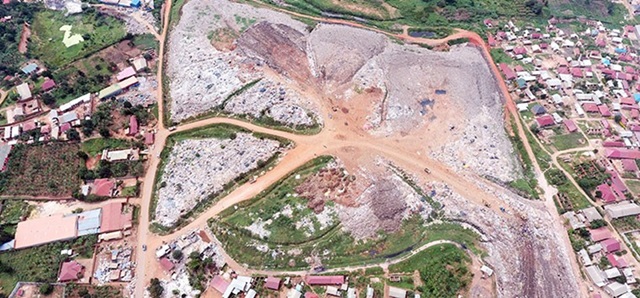Let’s not waste Kiteezi garbage tragedy

Kiteezi landfill in 2017
Lessons from Ethiopia, Kenya, Nigeria
COVER STORY | THE INDEPENDENT TEAM | Until 2017, the Koshe Landfill on the edge of the Ethiopian capital,Addis Ababa, was just like the Kiteezi Garbage dumpsite on the northern edge of Kampala City.
On a typical day, several trucks carrying waste from the city would plough through gullied roads and climb up mountains of old waste to dump new waste. It was a sight to behold as hundreds of waste pickers scurried to rake among the waste with bare hands to retrieve whatever they hoped to either use or sell. Often the waste pickers would compete for the garbage against scavenging birds and dogs. It was dirty, smelly, and dangerous.
Then on March 11, 2017 a tragic event happened that would change Koshe Landfill and its community of residents and waste pickers forever. On that day, part of the largest hillside at the Koshe landfill site collapsed, burying a slum that had been built on the landfill. The dump was used to regular, small landslides, but this one killed 140 people.
The Ethiopian government was shocked into change mode. First it declared three days of national mourning. Then, working with UN-Habitat and the government of Japan, it begun urgent rehabilitation of the
50-year old dumpsite to avoid additional incidents or risk to the surrounding community. The dumpsite had been declared full but attempts to shift to another site were frustrated by several interest parties, including the waste pickers.
The rehabilitation project used the ‘Fukuoka Method’ to repair the collapsed area of the dumpsite and prevent further erosion and landslides in the surrounding settlements. The ‘Fukuoka Method’ was developed by Fukuoka University in Japan and focuses on a gas venting system and redirection and discharge of rain water and other liquid flows. This is mainly because, in typical open dumping, waste is layered on top of waste, creating mountains of waste with steep sides that breakdown in heavy rain causeing sudden landslides. Then in 2018, the government commissioned a 50-megawatt plant on the site of Koshe, Ethiopia’s largest rubbish dump. Hailed as Africa’s first major wasteto-energy plant, it was designed to dispose three-quarters of Addis Ababa’s garbage, provide energy to 25% of the population, and meet European standards on air emissions.
The facility is designed to process 1,400 tonnes of waste per day and generate 185 gigawatt hours of electricity annually which is connected to the national grid. At its inception, the project created jobs for 1,300 Ethiopians and 286 expatriates.
Change coming to Kiteezi
People living near the Kiteezi landfill site have complained that this landfill has made their place inhabitable and that land has lost value. But that could change soon if what happened at some dumpsites across Africa happens here.
The Olusosun dumpsite, a 100-acre dump in Lagos State, Nigeria, is a typical example. Considered the largest in Africa, and one of the largest in the world, it receives up to 10,000 tonnes of rubbish each day. Waste from around 500 container ships is also delivered to the site, adding a substantial portion of electronic waste. Some of this material is treated with chemicals to extract reusable products resulting in toxic fumes being released. Around 500 homes exist at the site in shanty towns, occupied by residents who work at the dump scavenging for scrap to sell.
Olusosun landfill, which was once considered to be on the outskirts of the Lagos populated area, has changed in recent years. It has undergone massive expansion and is now surrounded by commercial and residential areas.
Kiteezi is smaller than Olusosun but bigger than the Koshe dump. Estimated to be 29 acres big and receiving 2,500 tonnes of waste daily, it is considered one of the biggest landfills in Africa.
Only the 30-acre Dandora landfill in Nairobi, Kenya is bigger. It is the 12th largest in the world. Yet every single day it receives 2,000 tonnes of unsorted, unregulated waste from the city’s residents and businesses.
Up to 6,000 people make a living picking waste from the landfill site to sell, generating an income for over 3,000 families. Dandora dump was opened in 1975 and was deemed full by 2001 but it is still operational.
Comparatively, the Pugu dumpsite located nearly 35 km from the centre of Dar es Salaam in Tanzania receives about
1300-1700 tonnes per day. The area served is 1,493 square kilometres with a population of 7.4 million, comprising four municipalities and Dar-es-Salaam City. These are small operations compared to the Apex Region landfill in Las Vegas, USA, which is the largest in the world. It sits on 2200 acres.
Even before the tragic incident, Kiteezi was already feeling the pressure from its closeness to the city centre. To access it, the garbage trucks from Kampala City travel very short distances. They are covered once they hit the Kampala-Gayaza road (about 9 km from Kampala’s CBD), branch off to the left at Mpererwe and follow the bitumen road going to Namulonge (about 4km).
Initially designed with a total surface area of 0.04 km2 (10 acres) in 1996, it was extended to reach 0.11 km2 (about 27 acres).
Some reports indicate that its present size is 29 acres plus an additional 6 acres plot acquired on the south side for further extension. Kiteezi land is now well set for a scramble. And this could set that area up for another disaster.
Looming dangerTo describe Kiteezi and other dumps scattered across Ugandan towns as landfills is confusing because most of them are operated as open dumpsites not landfills. They lack fencing, barrier layers, soil cover, leachate and gas collection or treatment systems. In addition, the sites have steep slopes, poor access roads, puddles of leachate and other associated environmental hazards.
According to expert definitions, well-run landfills for non-hazardous waste meet predefined specifications by applying techniques to confine waste to as small an area as possible and compact waste to reduce volume. They also cover the waste daily with layers of soil or other types of material such as woodchips and fine particles.
Landfills should have plastic linings along the base, collect and treat the leachate. Leachate from landfills with high organics, if discharged into a river, increases its biochemical oxygen demand leading to low oxygen available to the existing living organisms. Organic matter also contains plant nutrients, especially nitrogen and phosphorus, which when released into water, may cause eutrophication.
When waste dumps are not properly managed they can pollute surface and underground water. This is critical for a dump like Kiteezi which is located in Nangabo Sub-County of Wakiso District, close to the shores of Lake Victoria.
Options for Kiteezi
The US$96 million Koshe waste-to-energy plant has not been talked about a lot since a landslide happened at Kiteezi dump near Kampala on Aug.10 when a mountain of garbage collapsed and buried people and houses.
By Aug.16 at least 35 bodies of the dead had been retrieved but speculation was rife that many more remained buried under the garbage and might never be recovered.
There has been speculation that an explosion of methane gas could have triggered the landslide as some of the survivors reported hearing an explosion shortly before the collapse.
Scientific explanations and real landfill accidents from methane gas explosions back-up such claims. One such explosion occurred in 1986 in Loscoe, England, when a landfill ground gas explosion, badly injured three people in a bungalow.
At Loscoe, the incident occurred because of a lack of understanding of the process operations and necessary controls, and, as such, the explosion could be seen as a direct consequence of the landfill operation.
Another landfill explosion was in Turkey. On April 28, 1993, an “explosion” took place, followed by the displacement of a large mass of solid wastes at Ümraniye-Hekimbaşi open dump accident that engulfed II houses causing the death of 39 people.
In Uganda, the Kiteezi incident has sparked wide debate on solid waste generation and collection models and the energy potential of landfills.
Rescue operations after the accident were rudimentary
Located to the north of Kampala City about 13 km from the City centre, the Kiteezi Landfill is interesting because of the type of waste that is dumped there. Over 90% of the waste is organic, including food waste, market residuals, and vegetation. These constitute 92.66% of all garbage according to one study. Plastics, both soft and hard constitute 3.72%, paper (packaging) 1.62%, broken glass 0.68%, textiles (rugs) 0.50%, metals (scrap) 0.16%, and so-called special waste 0.66%.
This waste composition has for some time rendered Kiteezi landfill a contender for waste-to-energy project. In one case, Swedish experts visited the Ugandan capital in November 2021 to evaluate local conditions to implement a full-scale wasteto-energy plant.
At the time, it was already clear that the Kiteezi landfill had reached its maximum capacity and the city was considering alternative solutions. However, as the Ethiopian example illustrates, this possibly needs to be a government-led project.
In waste-to-energy incineration plants, rubbish is burned in a combustion chamber. The resulting heat is used to boil water until it turns to steam, which drives a turbine generator that produces electricity.
In cities such as Kampala where land is in short supply, “waste-to-energy” incineration saves precious space, generates electricity, prevents the release of toxic chemicals into groundwater, and reduces the release of methane – a potent greenhouse gas generated in landfills – into the atmosphere.
Waste incineration is popular in Europe, where nearly one quarter of all municipal solid waste is incinerated. France has 126 waste-to-energy plants, while Germany has 121 and Italy 40.
A consortium of international companies already exists to design, construct and in some cases own waste-to-energy facilities customised for Sub-Saharan Africa. The consortium includes Cambridge Industries Limited (Singapore), China National Electric Engineering, and Ramboll, a Danish engineering firm. The Ethiopian plant was the first of its intended facilities for major cities such as Kampala.
The Ethiopian plant has been cited in a many studies on innovations in Africa’s waste material management.
Kenya’s model which focuses on well-managed waste collection, sorting, composting, plastic recycling, and purchasing waste from waste materials pickers is also often touted. Led by a company called Taka Taka, this model is said to have enabled affordable waste collection services to low-income areas by pushing to recycle up to 90% of all collected waste material using mainly women and youth. Taka Taka’s state-of-the-art waste collection and processing uses modern screening technology that efficiently segregates recyclable material. It has also reduced Kenya’s gas emission effluents that resulted in a clean and healthy environment in Kenya.
Opportunities in the crisis
Other new technology based waste disposal and management companies are to be found in South Africa. These companies leverage user-friendly smartphone applications to facilitate prompt service, extra pickups, and bill payment through push notifications.
The new technology, for example, has introduced automated waste management sensors that trigger instant alerts every time a container is full and needs service. Consequently, this technology has effectively enhanced cost-effective waste collection costs by simplifying the waste material collection processes.
There are also mechanical-biological treatment methods that combine mechanical and biological treatment methods, supported by pre-treatment sorting techniques and emission selection and quality control techniques.
Others are anaerobic digestion constituting the decomposition of organic waste in the absence of oxygen as in the Fukuoka Model.
There is also the landfill gas-to-energy where the landfilling is executed to the mass disposal of waste to land under controlled circumstances. In this case, the energy is recovered from the waste by collecting gases arising from the natural decomposition of the waste material.
According to a report for the AU High- Level Panel on Emerging Technologies (APET), Africa’s rapid population growth, increasing economic activities, and everexpanding urbanisation have resulted in unprecedented waste materials.
It projects that by 2050, the volume of waste will triple from 174 million tonnes per year as of 2016 to approximately 516 million tonnes per year across the African continent. However, Africa’s average waste collection rate is approximately 55% of all the existing waste materials. It says more than 90% of
Africa’s waste is disposed of at uncontrolled dumpsites and landfills, often followed by open burning.
“The waste pollution from these sites has reached a state of emergency across the African continent,” says the 2021 report, “Africa needs to pursue sustainable waste management approaches to ensure the appropriate preservation of the environment and curb possible further pollution.”
Most importantly, 19 of the world’s 50 biggest dumpsites are found in Africa and are mostly located in Sub-Saharan Africa. It cites African Union’s Agenda 2063: “The Africa We Want,” with Goal 7 aspiring for environmentally sustainable and climate-resilient economies within African communities.
The report says, by composition, an average of approximately 13% of municipal solid waste generated in Africa is plastic, and 57% constitute organic waste.
The bulk of organic waste is currently being dumped in landfills yet organic waste could provide significant socio-economic opportunities for African countries.
The post Let’s not waste Kiteezi garbage tragedy appeared first on The Independent Uganda:.





